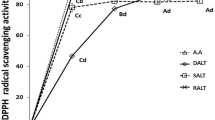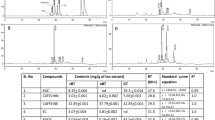Abstract
The present study compared the antioxidant and antiproliferative activities of green and black tea samples extracted by microwave heating. The antioxidant potential was analyzed at different concentrations of 20, 50, 70 and 100 μg/ml through 1,1-diphenyl-2-picrylhydrazyl (DPPH) scavenging, reducing power, lipid peroxidation and oxidative damage to DNA. The standards α-tocopherol (TO), rhutin (RH) and butylated hydroxyl toluene (BHT) were used for comparison. Green tea extract was found to have a higher total phenolic and flavonoid content (659 and 1680 mg GAE/ml of extract, respectively) than black tea extract (596 and 1586 mg GAE/ml of extract, respectively). All the antioxidant assays revealed that the antioxidant potential of green tea extract was better than that of black tea extract but lower than that of the standards. Green tea extracts (86.05%) also showed a higher antiproliferative effect than black tea extracts (59.34%). It was concluded that green tea exhibited better antioxidant and antiproliferative potential than black tea.
Similar content being viewed by others
References
Muktar H, Ahmad N (2000) Tea polyphenols: prevention of cancer and optimizing health. Am J Clin Nutr 71(6 Suppl):1698–1702
Obanda M, Owuor OP, Mang’oka R (2004) Changes in thearubigen fractions and theaflavins levels due to variations in processing conditions and their effects on black tea liquor brightness and total colour. Food Chem 85:163–173
Balentine D (1992). Manufacturing and chemistry of tea phenolic compounds in food and their effects on health. American Chemical Society, Washington, DC, 102–117
Vinson JA, Dabbagh YA, Serry MM, Jang J (1995) Plant flavonoids, especially tea flavonols, are powerful antioxidants using an in vitro oxidation model for heart disease. J Agric Food Chem 43:2800–2802
Dufresne CJ, Farnworth ER (2001) A review of latest research findings on the health promotion properties of tea. J Nutr Biochem 12:404–421
Rietveld A, Wiseman S (2003) Antioxidant effects of tea: evidence from human clinical trials. J Nutr 133(10):3285–3292
Ahamd M, Baba WN, Shah U, Gani A, Gani A, Riyaz A, et al. (2014) Nutraceutical properties of the green tea polyphenols. J Food Process Technol, http://dx.doi.org/10.4172/2157-7110.1000390
Ahmad M, Gani A, Baba WN, Wani TA, Gani A, Shah U, Wani SM, et al. (2015) Effect of green tea powder on thermal, rheological & functional properties of wheat flour and physical, nutraceutical & sensory analysis of cookies. J Food Sci Technol 52(9):5799–5807
Chen Y, Xie YM, Gong FX (2007) Microwave-assisted extraction used for the isolation of total triterpenoid saponins from Ganoderma atrum. J Food Eng 81:162–170
Hao J, Han W, Huang S, Xue B, Deng X (2002) Microwave-assisted extraction of artemisinin from Artemisia annua L. Sep Purif Technol 28:191–196
Hemwimon S, Pavasant P, Shotipruk A (2007) Microwave-assisted extraction of antioxidative anthraquinones from roots of Morinda citrifolia. Sep Purif Technol 54:44–50
Liao ZG, Wang GF, Liang XL, Zhao GW, Jiang QY (2008) Optimization of microwave-assisted extraction of active components from Yuanhu Zhitong prescription. Sep Purif Technol 63(2):424–433
Pan X, Niu G, Liu H (2002) Comparison of microwave-assisted extraction and conventional extraction techniques for the extraction of tanshinones from Salvia miltiorrhiza Bunge. Biochem Eng J 12:71–77
Rostagno AM, Palma M, Barroso GC (2007) Microwave-assisted extraction of soy isoflavones. Anal Chim Acta 588:274–282
Wang J, Yuan X, Jin Z, Tian Y, Song H (2007) Free radical and reactive oxygen species scavenging activities of peanut skins extract. Food Chem 104:242–250
Xiao W, Han L, Shi B (2008) Microwave-assisted extraction of flavonoids from Radix astragali. Sep Purif Technol 62:616–620
Zhang B, Yang R, Liu ZC (2008) Microwave-assisted extraction of chlorogenic acid from flower buds of Lonicera japonica Thunb. Sep Purif Technol 62:480–483
Gani A, Rasool N, Shah A, Ahmad M, Gani A, et al. (2014) DNA scission inhibition, antioxidant, and antiproliferative activities of water chestnut (Trapa natans) extracted in different solvents. CyTA J Food, http://dx.doi.org/10.1080/19476337.2014.992967
Boateng J, Verghese M, Walker LT, Ogutu S (2008) Effect of processing on antioxidant contents in selected dry beans (Phaseolus spp. L.). LWT Food Sci Technol 41:1541–1547
Ahmad M, Gani A, Baba WN, Gani A, Masoodi FA, Shah A, Rather SA (2014) Effect of extraction time on physiologically important constituents of green tea (Camellia sinensis) using GC/MS. J Food Process Technol, http://dx.doi.org/10.4172/2157-7110.1000276
Baba N, Rashid I, Shah A, Ahmad M, Gani A, Masoodi FA (2014) Effect of microwave roasting on antioxidant and anti-cancerous activities of barley flour. J Saudi Soc Agric Sci 27:143–154
Osawa T, Namiki M (1981) A novel type of antioxidant isolated from leaf wax of eucalyptus leaves. Agric Biol Chem 45:735–739
Ganie S, Jan A, Muzaffar S, Zargar BA, Hamid R, Zargar MA (2012) Radical scavenging and antibacterial activity of Arnebia benthamii methanol extract. Asian Pac J Trop Med 5(10):766–772
Shah A, Ahmad M, Ashwar BA, Gani A, Masoodi FA, Wani IA, Gani A (2015) Effect of γ-irradiation on structure and nutraceutical potential of β-d-glucan from barley (Hordeum vulgare). Int J Biol Macromol 72:1168–1175
Stewart AJ, Mullen W, Crozler A (2005) On-line high-performance liquid chromatography analysis of the antioxidant activity of phenolic compounds in green and black tea. Mol Nutr Food Res 49:52–60
Rio D, Stewart AJ, Mullen W, Burns J, Lean MEJ, Brighenti F, et al. (2004) HPLC-MSn analysis of phenolic compounds and purine alkaloids in green and black tea. J Agric Food Chem 52:2807–2815
Rusak G, Komes D, Likic S, Horzic D, Kovac M (2008) Phenolic content and antioxidative capacity of green and white tea extracts depending on extraction conditions and the solvent used. Food Chem 110:852–858
Erkan N, Ayranci G, Ayranci E (2008) Antioxidant activities of rosemary (Rosmarinus officinalis L.) extract, blackseed (Nigella sativa L.) essential oil, carnosic acid, rosmarinic acid and sesamol. Food Chem 110:76–82
Duh PD (1998) Antioxidant activity of burdock (Arctium lappa Linné): its scavenging effect on free-radical and active oxygen. J Am Oil Chem Soc 75:455–461
Gordon MH (1990) The mechanism of antioxidant action in vitro. In BJF Hudson (ed) Food antioxidants. London: Elsevier Science, 1–18
Lin SD, Liu EH, Mau JL (2008) Effect of different brewing methods on antioxidant properties of steaming green tea. LWT Food Sci Technol 41:1616–1623
Lopez-Velez M, Martinez-Martinez F, Del Vale-Ribes C (2003) The study of phenolic compounds as natural antioxidants in wine. Crit Rev Food Sci Nutr 43:233–244
Halliwell B (1994) Free radicals, antioxidants, and human disease: curiosity, cause, or consequence? Lancet 344:721–724
Husain SR, Cillard J, Cillard P (1987) Hydroxyl radical scavenging activity of flavonoids. Phytochemistry 26:2489–2491
Mohan KVPC, Gunasekaran P, Varalakshmi E, Hara Y, Nagini S (2007) In vitro evaluation of the anticancer effect of lactoferrin and tea polyphenol combination on oral carcinoma cells. Cell Biol Int 31:599–608
Hwang JT, Ha J, Park IJ, Lee SK, Baik HW, Kim YM, et al. (2007) Apoptotic effect of EGCG in HT-29 colon cancer cells via AMPK signal pathway. Cancer Lett 247:115–121
Shi X, Dalal NS, Jain AC (1991) Antioxidant behaviour of caffeine: efficient scavenging of hydroxyl radicals. Food Chem Toxicol 29:1–6
Author information
Authors and Affiliations
Corresponding author
Rights and permissions
About this article
Cite this article
Shah, S., Gani, A., Ahmad, M. et al. In vitro antioxidant and antiproliferative activity of microwave-extracted green tea and black tea (Camellia sinensis): a comparative study. Nutrafoods 14, 207–215 (2015). https://doi.org/10.1007/s13749-015-0050-9
Received:
Accepted:
Published:
Issue Date:
DOI: https://doi.org/10.1007/s13749-015-0050-9




